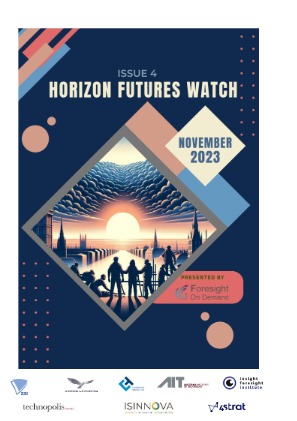The seventh Horizon Futures Watch online dissemination workshop took place on November 15 2023 and explored possible futures of innovation and IP regulation. The topic proved rich in discussion points, challenges, and questions related to the future.
Intellectual Property Rights (IPR) are typically viewed as a cornerstone for innovation, because they facilitate knowledge transactions that might otherwise be hindered due to the public good nature of knowledge. Thus IPR are seen as crucial in promoting creative and inventive activities. However, some critics argue that IPR can be a costly market distortion, inhibiting rather than encouraging innovation. IPR institutions are increasingly under scrutiny amidst evolving innovation trends and changes. IPR, known for their technical complexity and variability across legal jurisdictions, are facing diverse challenges, reflecting the dynamic nature of modern innovation and innovation policy. Amongst the important shifts are trends towards more inclusive, open innovation processes involving various stakeholders and the growing influence of digitalization.
The presentation of scenarios relating to the future of intellectual property was the cue for participants, speakers, and experts alike to begin teasing out the underlying implications of IP for innovation and patenting. The scenarios evolved along important emerging trends and were mapped along two dimensions: private versus public use of IP, and concentration of power versus distribution of power. These dimensions, along with a definition of key drivers and main actors, yielded the following five scenarios:
- End of IP as we know it – Key actors are large cloud-based giants and trade secrets are a prevalent form of IP. Europe loses value as tech giants are not based in Europe. Unitary patent loses meaning. Policy implications: anti-trust and ex-ante regulation are of utmost importance to avoid obscured private governance of IP.
- ‘Creative destruction’ of the IP regime – Drivers include the speed of technological change, increasing technological complexity, and disruptive technologies. Europe faces regulatory challenges. Regarding policy implications, the aim is to maintain the quality of IPR and IP authorities are encouraged to operate in the public interest.
- IP a battlefield of geopolitics – EU hands out strong security patents within a harmonized IPR regime. In regulation, mandatory mediation is paramount and the mediator has access to agreements from patent owner.
- Global and balanced IP for open innovation – IP is lean toward access. Drivers include public interest, global IP, and the movement of public goods. AI and digitalization play a role in ensuring transparency, monitoring, and innovation. Science has become the solution to address extreme weather events. Public funding ensures that there is open access to public research results.
- Open-source collaboration globalized innovation – Innovation is driven by collaborative communities and startups. There is capacity to regulate access to EU internal market and influence global supply chains.
The audience offered commentary and discussed the individual scenarios. One participant noted that several scenarios focused primarily on IP and innovation from a techno-centric perspective, suggesting a need for greater emphasis on the social context of innovation. A point was made about how the fourth scenario, which dealt with global and balanced IP, better addressed this aspect by highlighting the implications of patents for public good in the context of COVID. One of the projects presented subsequently, Creative IPR, further touched upon these implications for the creative industries, namely pointing to the impact of the COVID crisis on revenue generated from copyrights, particularly for the music sector. The project coordinator argued that the pandemic highlighted the vulnerability of the music industry due to a heavier reliance on copyright for revenue compared to a more resilient sector, such as fashion design and textiles. This raised questions about how to best support the music industry through IP in times of crisis.
Touching upon the technological implications for IP, a representative from the World Intellectual Property Organisation (WIPO), argued that human contribution to innovation will not be replaced by AI, but that a lot of AI applications rely on training data, which still makes use of human creativity. He argued that in Europe, one area that has seen the strongest progress is digital technology, at the expense of more traditional technologies such as mechanical, chemical, and technical engineering, which have witnessed a reduced number of patent filings. On the other hand, he stressed how the fastest growth in patent development in East Asia questions how European companies should prepare for a changing landscape in innovation reflected in intellectual property.
One remark in reaction to this was a caution not to forget traditional technologies, and not to assume that these would be overshadowed by aspects such as digitalization, but to continue fostering this strength in traditional technologies. While Europe is a follower in the area of digitalisation, AI-generated products are still driven by human creativity and engineering, highlighting the importance for regulators not to forget about this link.
Referencing the fourth scenario, another participant argued that countries in East Asia, such as India, which advocate for more access, may contribute to a changing geopolitical landscape towards access, fostered by national trade interests. Focusing more on production and less on usage could lead to duplicating many existing patents. At the same time, this approach might also entail increased international collaboration and bilateral relations, pooling resources to accelerate innovation.
The overall discussion highlighted the need to strike a balance between innovation incentives and the right to access. It is essential to find a middle ground that encourages creative and scientific advancement while ensuring information and educational resources remain accessible to all.








